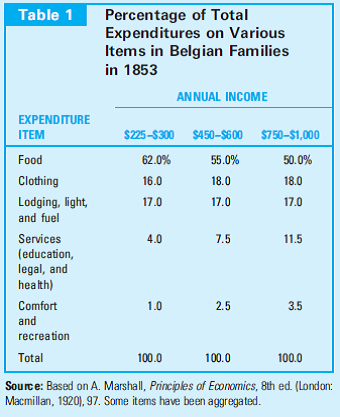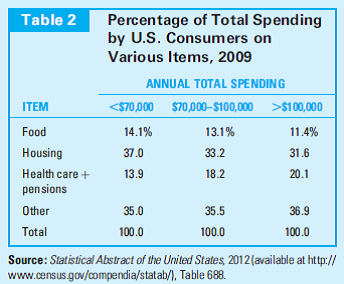
Intermediate Microeconomics and Its Application 12th Edition by Walter Nicholson,Christopher Snyder
Edition 12ISBN: 978-1133189022
Intermediate Microeconomics and Its Application 12th Edition by Walter Nicholson,Christopher Snyder
Edition 12ISBN: 978-1133189022 Exercise 35
Engel's Law
One of the most important generalizations about consumer behavior is that the fraction of income spent on food tends to decline as income increases. This finding was first discovered by the Prussian economist Ernst Engel (1821-1896) in the nineteenth century and has come to be known as Engel's Law. Table 1 illustrates the data that Engel used. They clearly show that richer families spent a smaller fraction of their income on food.
Recent Data
Recent data for U.S. consumers (see Table 2) tend to confirm Engel's observations. Affluent families devote a smaller proportion of their purchasing power to food than do poor families. Comparisons of the data from Tables 1 and 2 also confirm Engel's Law-even current low-income U.S. consumers are much more affluent than nineteenth-century Belgians and, as might be expected, spend a much smaller fraction of their income on food.
Are There Other Laws?
Table 2 also shows a tendency for the share of spending on housing to fall as income rises and a tendency for spending on health and pensions to rise with income. Whether these trends have the same generality as Engel's Law is open to question, however. Spending on these items can be affected in important ways by the business cycle (2009 was a year of major recession) and by the availability of public programs providing the same goods (such as Medicare or Medicaid). More detailed studies that seek to control for such influences have generally failed to identify regularities as significant as those identified by Engel over 150 years ago.
How do you think the availability of Food Stamps for lowincome people would affect the figures in Table 2?
One of the most important generalizations about consumer behavior is that the fraction of income spent on food tends to decline as income increases. This finding was first discovered by the Prussian economist Ernst Engel (1821-1896) in the nineteenth century and has come to be known as Engel's Law. Table 1 illustrates the data that Engel used. They clearly show that richer families spent a smaller fraction of their income on food.

Recent Data
Recent data for U.S. consumers (see Table 2) tend to confirm Engel's observations. Affluent families devote a smaller proportion of their purchasing power to food than do poor families. Comparisons of the data from Tables 1 and 2 also confirm Engel's Law-even current low-income U.S. consumers are much more affluent than nineteenth-century Belgians and, as might be expected, spend a much smaller fraction of their income on food.

Are There Other Laws?
Table 2 also shows a tendency for the share of spending on housing to fall as income rises and a tendency for spending on health and pensions to rise with income. Whether these trends have the same generality as Engel's Law is open to question, however. Spending on these items can be affected in important ways by the business cycle (2009 was a year of major recession) and by the availability of public programs providing the same goods (such as Medicare or Medicaid). More detailed studies that seek to control for such influences have generally failed to identify regularities as significant as those identified by Engel over 150 years ago.
How do you think the availability of Food Stamps for lowincome people would affect the figures in Table 2?
Explanation
The availability of food stamps for low-...
Intermediate Microeconomics and Its Application 12th Edition by Walter Nicholson,Christopher Snyder
Why don’t you like this exercise?
Other Minimum 8 character and maximum 255 character
Character 255



